Renting a car and driving yourself around Costa Rica is the best way to explore this natural wonderland. In this post, we'll share our Costa Rica road trip itinerary and tons of tips to help you plan an epic journey by car.
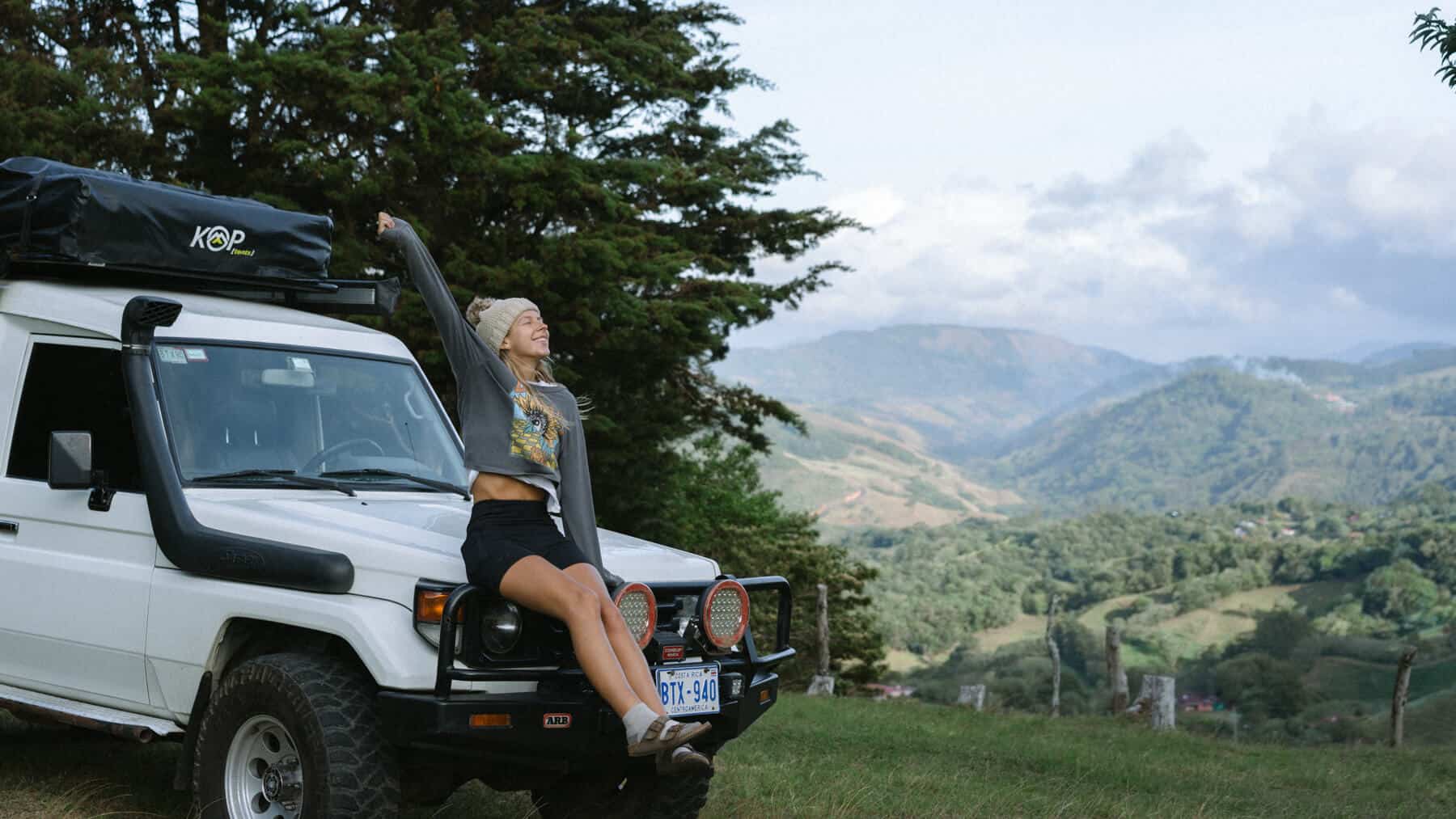
This article may contain affiliate / compensated links, that may earn me a small commission, at no extra cost to you. For full information, please see our disclaimer here. While all efforts have been taken to ensure the information included in this post is correct and current, travel information such as opening hours, business operations and prices change frequently. If you find anything in this post that is incorrect or outdated please let me know in the comments so I can update it for other readers.
Your guide to road tripping Costa Rica
Renting a car and driving in a foreign country can be intimidating. Believe me, I know, we're Australian and most of the countries we visit drive on the other side of the road!
But Costa Rica is one of those places where the rewards of renting a car far, far outweigh any anxiety or hesitation.
Having the freedom to chart your own course in this natural wonderland is a truly special experience, and I guarantee one of the best holidays you've ever had.
In this Costa Rica road trip guide, I'm going to share everything you need to know to plan an epic journey through Costa Rica by car.
It's a big post, so use the table of contents to navigate as you need. If you want to skip the boring logistical stuff, go straight to the road trip itinerary section.
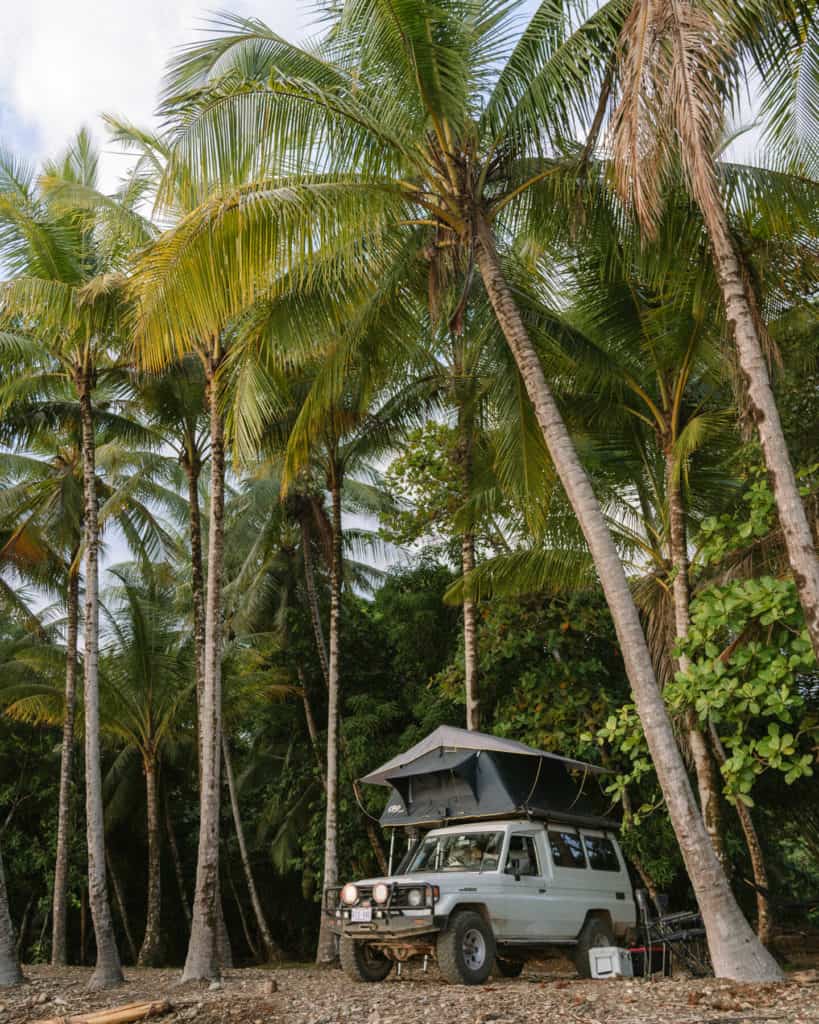

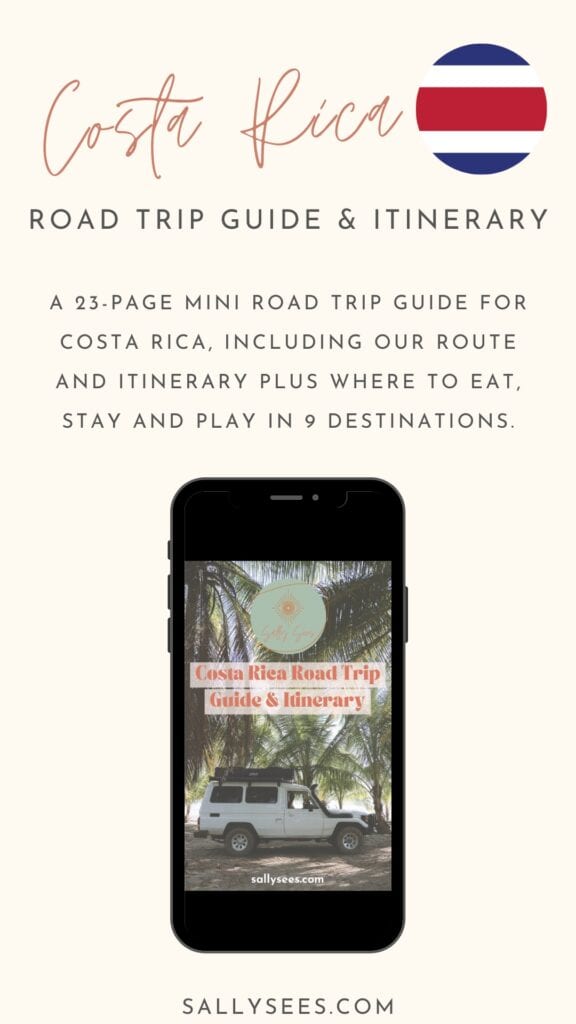
Why a road trip is the best way to see Costa Rica
Renting a car and driving yourself around Costa Rica is without a doubt the best way to experience this magical country for so many reasons.
- 🚌 Public transport isn't great: while you can get around the country by bus, many long-distance routes go via San Jose, so you’ll constantly need to go in and out of the capital for connections (and it’s not a nice place to be!). Once you arrive in a town, local transport is very limited and leaves you relying on expensive taxis or tours to see the sights.
- 🚐 Tourist shuttles are expensive: tourist shuttles travel directly between popular destinations, picking you up from your hotel in A and dropping you off in B. This solves the problem of buses, but they are very expensive. Prices start from around $30 USD but can go up to $80 + if it’s a lengthier route. If you’re going to take a shuttle 5 times, you may as well rent a car.
- 🚗 See more by using travel days: if you’re taking public transport and hauling your luggage around, you can’t really use travel days as exploring days, so you’re constantly wasting time in your itinerary. Having a car means the days you move between destinations can also be normal sightseeing days, stopping at places along the way as you can easily store your luggage in the car. Plus driving is always quicker than taking public transport.
- ⏰ You have FREEDOM: having a car gives you complete control over your itinerary and schedule. You can go absolutely anywhere you like, past the tourist trail, outside of the bus route, seeing places in Costa Rica that most people never ever do! Explore aimlessly – if there’s a jungle-lined road that looks cool, take it! If you see a troop of squirrel monkeys on the road, pull over! If Google Maps shows a waterfall that you’ve never heard of, check it out!
- 🌅 You can get to places early: this might not sound like a big deal, but if you want to experience Costa Rica’s most popular parks and tourist attractions without the crowds you have to arrive early. Using public transport means you’re tied to the first bus of the day, which is often well past the opening hours of attractions.
- 👩🏼🤝👨🏻 You don't need to take as many tours: most tours in Costa Rica are really only to provide transport to people who don’t have their own wheels. They are expensive, and in many cases, are for activities that you can easily do independently without a guide. You’ll save a lot of money, and experience places on your own, which is the way we like to travel. (Don’t skimp on guides for wildlife experiences though, you will learn a lot and see a ton more animals!).
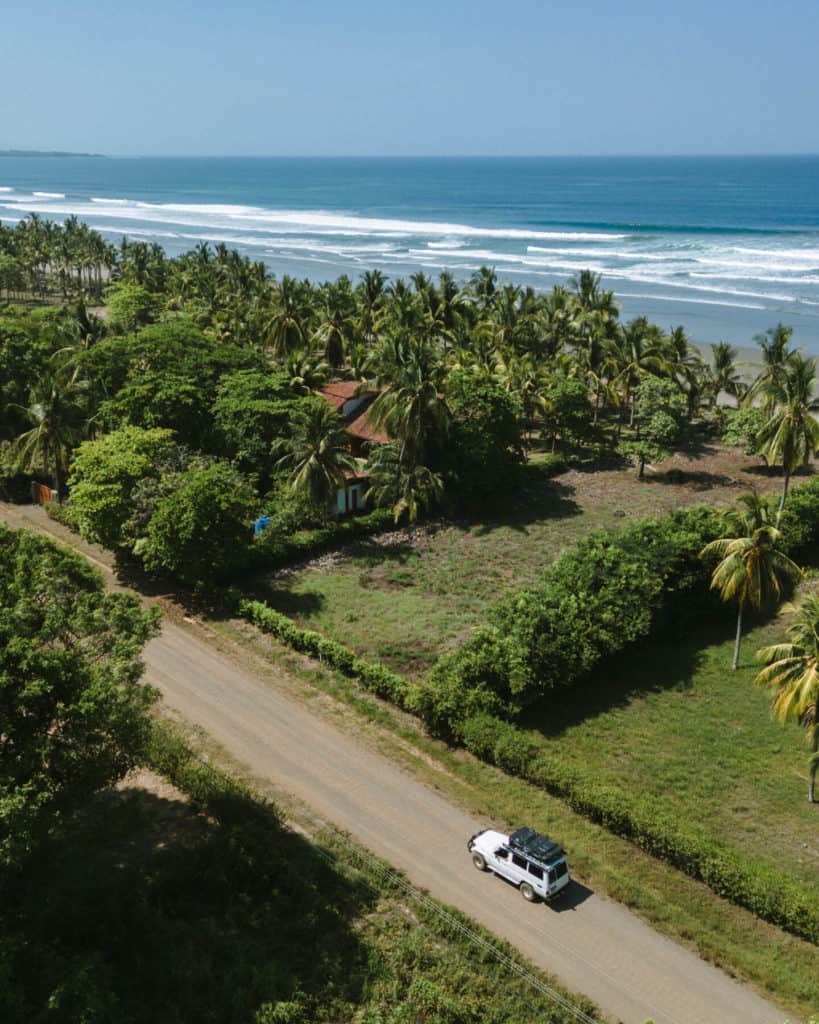
Renting a car in Costa Rica
The best place to rent a car in Costa Rica is the capital, San Jose.
Whilst it is possible to organise rentals in other tourist towns around the country, San Jose has the most rental companies, so prices are generally more competitive here.
If you are flying into Costa Rica, this is most likely where you’ll arrive anyway, so it's very convenient. Most rental companies will meet you at the airport.
My Costa Rica road trip itinerary has you starting and finishing in San Jose, which avoids any hefty one-way rental fees.
There are hundreds of rental car companies in San Jose. You’ll find all the usual international companies like Budget, Europcar, Sixt etc.
But there are also a lot of local rental companies, which generally offer much better service and include all the taxes and insurance costs in their quotes.
This leads me to my next section… rental car insurance.

Rental car insurance
The most important thing to understand about renting a car in Costa Rica is the insurance aspect.
There are several different insurances to take into consideration.
The biggest issue tourists run into is seeing a very cheap quote online, but only to realise when you collect the vehicle, that the mandatory insurances weren’t included, and they've whacked on a couple of hundred dollars more to pay before you can drive away with your car.
I’ve provided a brief summary of the different insurances below, but I would recommend reading this article for a lot more detail.
👉🏼 Mandatory liability insurance
Every single car rental agency in Costa Rica will charge you a mandatory liability insurance fee. This is basically insurance that covers any damage you cause to other people, cars, property etc.
There is no getting out of this or substituting this with your credit card/travel insurance.
If you’re looking at rental cars online, and you don’t see this mentioned on the quote, it's almost certain this fee will be added on when you pick up the vehicle.
If the price online seems too good to be true, it’s because this mandatory insurance isn’t included.
Local rental agencies are generally much more transparent about this, and I would always suggest renting from a Costa Rican-owned agency, vs a large international option.
👉🏼 Collision damage insurance
On top of the liability insurance, there is insurance that covers damage to your own rental car.
The most common term is ‘collision damage waiver’ or ‘car protection insurance’, which covers any damage you cause to your car.
Different rental agencies may have different levels of this insurance, and it will mostly boil down to what excess / deductable you will have to pay if you damage the car.
This insurance is what you might be able to substitute with your credit card or travel insurance. Most policies have a provision for rental cars and will cover the cost of damage or excess.
Generally, the rental agency will need to see evidence of this before they allow you to opt out of their insurance, and hand the car over, so they know someone will be footing the bill in case of an accident.
👉🏼 Optional insurance
On top of this, most agencies will also offer additional, optional insurance. This is usually labelled ‘premium' coverage.
Usually, this additional insurance is designed to reduce your excess / deductible to nothing, so in the case of a crash, you won’t have to pay anything and you're not liable.
If you’ve got good travel or credit card insurance, you shouldn’t have to pay anything in case of a crash either. However, you may have to pay the car rental agency's bill upfront, and then apply for a refund from the insurer.
Opting for this optional insurance means that you and the rental agency have an agreement directly that you don’t pay anything at all because you’ve opted for this premium, full coverage insurance.

Do you really need a 4×4?
Another major factor to consider when renting a car in Costa Rica is whether you need to rent a 4×4.
The roads in Costa Rica are in very mixed condition. Most of the main highways are fine. They’re well-paved, multi-lane and driving is easy. But so many roads are unpaved, and many others that are paved, are actually in worse condition as they are so full of potholes!
This is common all over the country, even in very popular tourist destinations. Don’t think that because somewhere is popular the roads must be good – WRONG!
There are certain routes around the country where you’ll need to specifically research which route to drive, and take what Google Maps or Waze provides with a grain of salt to avoid very rough roads or even river crossings (e.g. driving to Monteverde, or on the Nicoya Peninsula).
If money isn’t an issue, rent a 4×4. It will give you complete freedom to go anywhere and follow any unpaved road you see without hesitation or anxiety over damaging your rental car.
Some of the best parts of Costa Rica are down dirt roads. Hidden waterfalls, beachfront camp spots and palm-lined tracks that are just begging to be explored are much more accessible with a 4×4.
For most people though, understandably money is an issue, and renting a 4×4 is substantially more expensive than renting a standard sedan.
If you’re just visiting Costa Rica for a short time and sticking to the main sites (e.g. La Fortuna and Manuel Antonio) you can survive without one. You will encounter unpaved roads and roads riddled with potholes, but with slow and careful driving you will be fine.
But if you’re taking on a more comprehensive Costa Rica road trip like we suggest, and want total freedom and flexibility to go anywhere and see everything, it is worth considering.
Some other factors to aid in your decision to rent a 4×4:
- 🌦️ Wet vs dry season: the roads are much easier to navigate in the dry season (November – April). Once it starts raining, rivers can flood, unpaved roads become washed out and some routes are even impassable. If you’re visiting in the wet season, a 4×4 is much more important.
- 🛻 Off-the-beaten-track destinations: how long are you going to be road-tripping around Costa Rica? Do you want to visit places like Drake Bay with a car? A lot of the Nicoya Peninsula? These destinations have very poor roads, and if you want to explore them on your own terms, a 4×4 is usually necessary.
- 😬 Your anxiety and driving skills: will you be worried about taking a small sedan on unpaved roads? Are you going to constantly feel anxious about damaging the car and having a hefty repair bill? It’s worth spending the extra money so you enjoy your trip without worrying the whole time.
If you want a 4×4, this is another reason to use a local car rental agency. Not only are they more transparent with their quotes and insurances, but they will usually be more upfront with the exact car you are renting.
If you want a 4×4, but rent from an international agency, you might end up with an SUV – which is NOT the same, and won’t give you the tough, offroad capabilities you’re looking for!
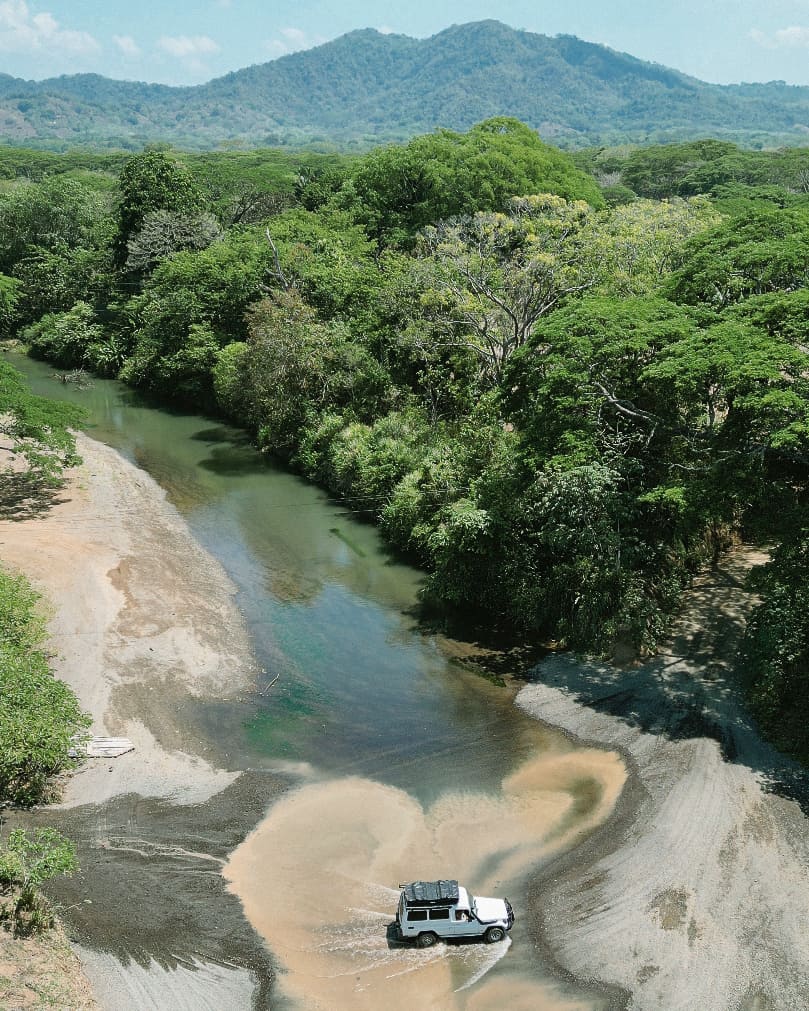

Renting a 4×4 camper
Money was an object for us when planning our Costa Rica road trip. However, having freedom and flexibility to explore the best parts of the country was a priority, so we came to a compromise.
We rented a 4×4 camper from Nomad America. Which gave us the ability to get offroad that we wanted, but also the ability to sleep and cook in the car.
It counteracted the cost of the expensive 4×4 rental, by reducing our accommodation and eating out costs.
I think in the end it all evened out, so we got the adventurous experience we wanted, without spending that much more than a small sedan plus standard accommodation and meals.
I’ve got more detailed posts about this if you’re thinking about going down this path:
- The Complete Guide to Camping in Costa Rica
- Nomad America 4×4 Camper Rental in Costa Rica – Our Review
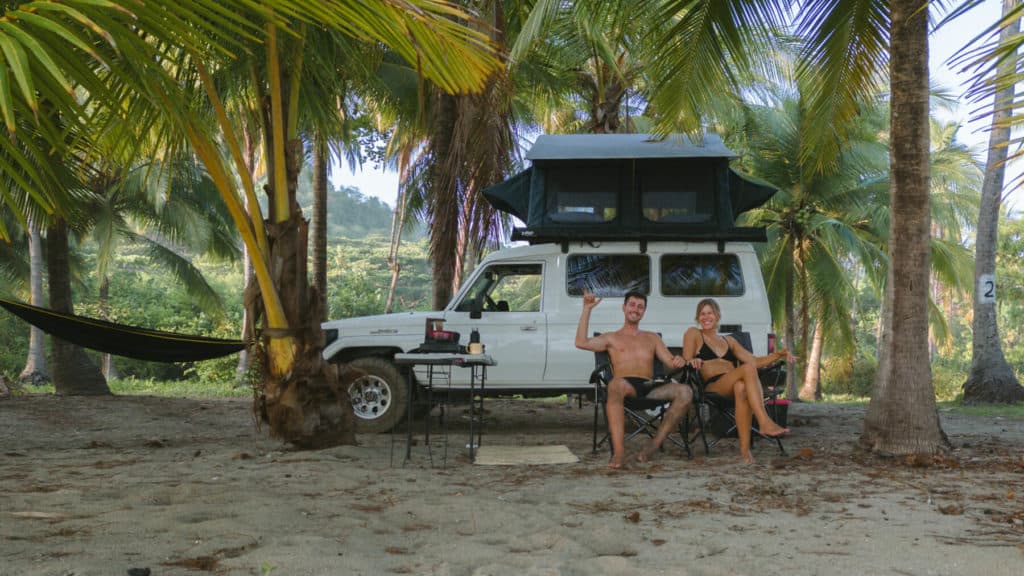
Driving in Costa Rica
Without trying to make this post enormous, I wanted to briefly mention a few points about driving in Costa Rica, that will be handy for planning and executing a stress-free road trip!
- ➡️ Right side: they drive on the right side of the road in Costa Rica.
- ⚖️ They use the metric system: speed limits are in kilometres per hour, and fuel is in litres, not gallons.
- ⛽️ Gas stations: are pretty prevalent but it’s good practice to fill up when you see one. Bajos del Toro and Drake Bay were two places that didn’t have any. Prices fluctuate, but we found fuel quite expensive in Costa Rica. The staff will pump for you, give them a small tip in cash. You can pay for your fuel with card.
- 💰 Toll roads: there are a fair few toll roads in and out of San Jose. It’s usually a couple of hundred Colones, and you can pay by cash or on card. If you’re not in a hurry, you can choose a route to avoid them, but generally, it’s quicker if you’re heading in or out of the city.
- 🗺️ Download Google Maps offline: phone service is poor in a lot of areas, so having the maps available offline is a lifesaver.
- 🛣️ Research your route in advance: before you set off for a day of driving, look properly at the map. Don’t rely blindly on Google Maps, as it often suggests strange routes that usually involve ‘shortcuts’ on insane unpaved roads. Stay on the highways as long as possible.
- 🚧 Drive slow: instead of getting into the specifics of Costa Rican driving abilities, just drive slow and always be on the lookout for people, animals, motorbikes, large trucks and buses and pushy drivers. If you drive slowly and stay alert, you’ll have no trouble driving here.
- 🅿️ Paid parking: in many popular tourist attractions, there will be parking attendants who watch your car and help you reverse out. Official or not, it’s a thing. In some destinations, they can be pushy mafia-style demanding a ridiculous fee, in others, they’re friendly and will accept a tip of your choice.
- 🌙 Avoid driving at night: roads are not well-lit, and with all the aforementioned hazards to watch out for, it’s safer to save long-distance trips for daylight hours.
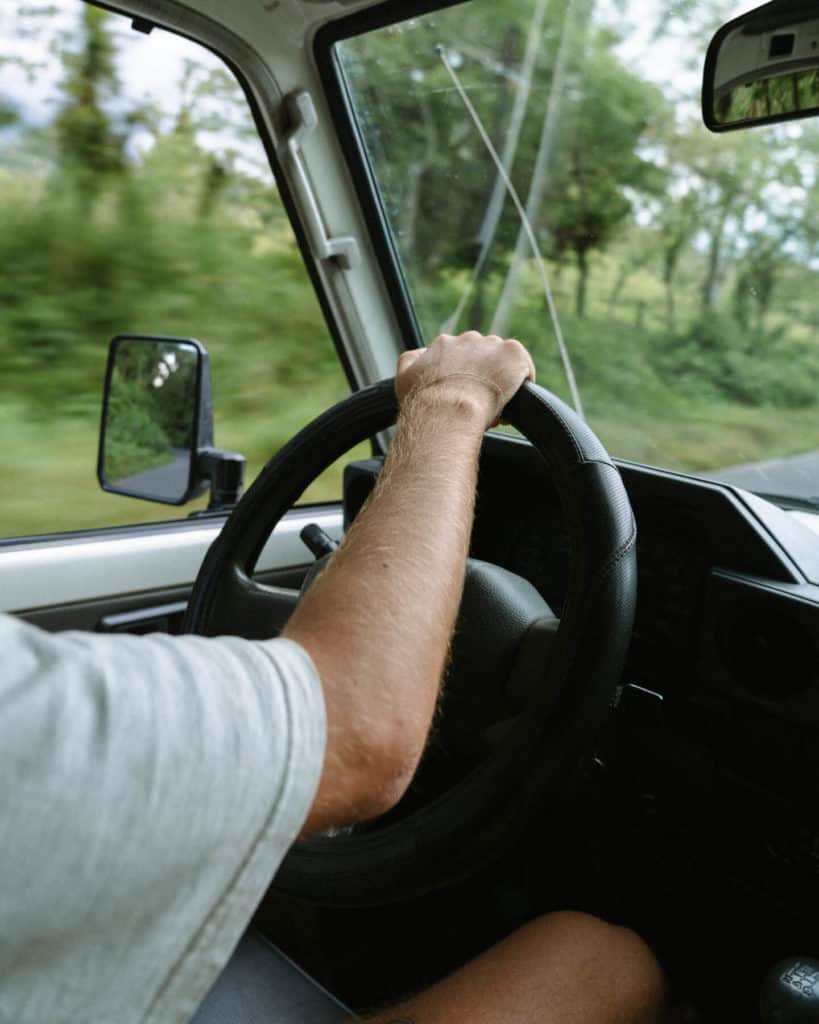
How long do you need for a Costa Rica road trip?
How long is a piece of string?! You could spend months in Costa Rica and not see it all!
If you have the luxury of choosing, I think a one-month Costa Rica road trip will give you a fantastic opportunity to see a broad cross-section of the country.
I haven’t provided specific days in my itinerary below, but rather I’ve included a suggested range of days in each place.
If you had a month, you could easily do this route. It would be quick, but because you’ve got a car and don’t waste your travel days, it’s feasible and not too rushed, with plenty of time to laze on the beach and enjoy some quiet mornings.
We spent 5 weeks in Costa Rica, 4 with a car, and it was a whirlwind, but we left feeling that we had given the country a good go.
If you’ve got that length of time, and you’re seeing a variety of places, the beauty is that you don’t have to do everything in each place to have a complete Costa Rica experience.
What I mean by this, is because Costa Rica has become such a touristy place, there are countless activities and tours to do in each destination (e.g. La Fortuna). But a lot of these are targeted at short vacationers who might be visiting one or two destinations over the course of one week.
They want to cram every experience into one destination – ziplining, white water rafting, hanging bridges, chocolate and coffee tours, night walks etc.
With a longer time and more destinations, you can choose the best places to do these experiences and do them once only. You don’t need to zipline 5 times.
So although you’re seeing more places, if you just focus on doing the activities that are unique or best in the area, you won’t need as long in each place as say the family cramming a jungle and beach adventure into just two places.

What time of year is best for a Costa Rica road trip?
In a climate like Costa Rica, you have to take the weather seriously.
🌦️ There is a dry season (usually November – April) and a wet season (usually May – October)
And when they say it’s going to rain, it will rain. It’s not constant the entire season, and you can still visit Costa Rica during its ‘green’ season and have a great trip.
But I hate people saying it's totally fine to visit in the peak of the rainy season.
It might be fine, because you could get lucky with a dry week. But you could also be unlucky with a storm front rolling through and a week of constant rain. That is the risk of wet season travel.
If you want to see the beaches looking blue and sparkly, see the waterfalls without them being brown and murky, and go hiking without getting drenched, you need to consider the seasons.
I know I was disappointed on the days we had heavy rain because although it is still beautiful, it does affect your plans. When you’re on a time limit, you don’t want to waste any precious moments exploring the country.
If you can visit during the dry season, do it.
December – February is the peak of this time, and will be the busiest and most expensive.
If you can plan your visit for a shoulder month (like November or March/April) you’ll skip some of the crowds but enjoy the best of the weather.
There are a few regional variations to take into consideration too:
- Caribbean Coast: the Caribbean Coast has a different wet/dry season to the rest of Costa Rica. It’s hotter and wetter year round, but the driest months (and the best time to visit) are February – March and August – September.
- Nicoya Peninsula: this is the driest part of the country, and although it does still experience a rainy season, it generally starts a bit later and doesn’t rain as often.
- South Pacific and Osa Peninsula: this is one of the wettest parts of the country, particularly the Osa which is a proper tropical rainforest that can be wet year-round. The wet season starts earlier here and is more intense.
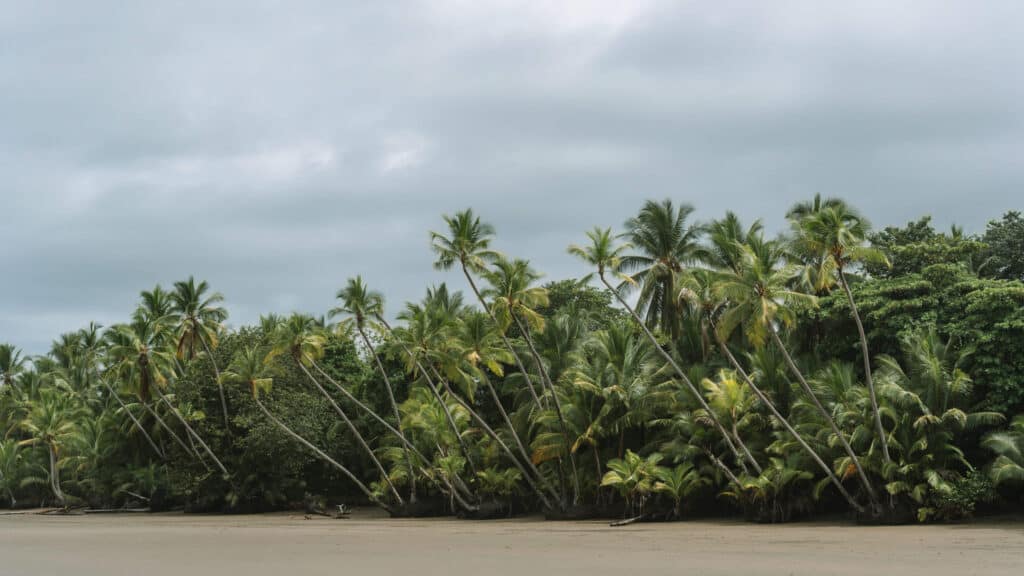
Costa Rica road trip itinerary
Finally, the fun part! Let's get into our Costa Rica road trip itinerary.
I’ve crafted this route based on our own experiences in Costa Rica, reflecting on our trip in hindsight and making minor changes that would have improved our route.
I’ve designed the route to start and end in San Jose, where most visitors will fly in and out of. And I’ve tried to minimize driving times, so you won’t spend entire days in the car.
My suggested route is:
San Jose – Puerto Viejo – Bajos del Toro – La Fortuna – Monteverde – Montezuma – Manuel Antonio – Uvita – Drake Bay – Dominical – San Jose

If you’re visiting Costa Rica as part of a broader trip through Central America, I’ve got some suggested alternative routes below, depending if you’re travelling southbound or northbound.
GET OUR COSTA RICA ROAD TRIP GUIDE
A 23-page mini road trip guide for Costa Rica, including our route and itinerary plus where to eat, stay and play in 9 destinations.
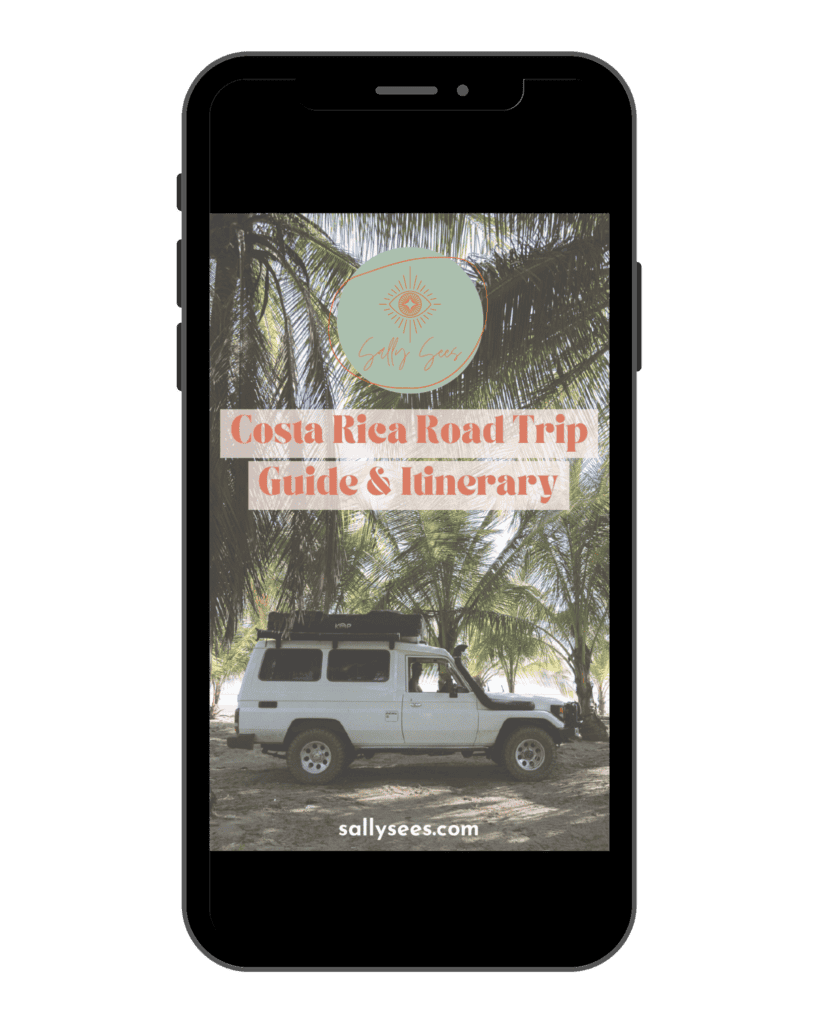
Starting your Costa Rica road trip in San Jose
Your epic Costa Rica road trip starts in the capital, San Jose. This is where the international airport is located, so chances are, you’ll fly in here.
If your flight arrives early in the morning, you can coordinate to pick up your rental car and start your journey straight away.
If you arrive later in the afternoon or evening, I would recommend spending a night in Alajuela (the area where the airport is) and collecting your car first thing the following morning.
You don’t want your first day of driving to be in the dark, and your first stop is 4 hours from San Jose.
In my opinion, it’s not worth spending any time in the city. Although there are some nice historic buildings, if you had to choose between that or more time in Costa Rica’s nature – it’s a no-brainer.
So don’t waste any time here, if you can plan your flight to arrive before lunchtime, you can get on the road straight away!
⏰ Driving time from San Jose to Puerto Viejo: 4 hours
🧭 Directions: this trip is mostly on well-made highways. It can be busy and stressful navigating out of the city, but once you're clear of that, this is a pretty easy drive.
Stop 1: Puerto Viejo
🌜 How long to spend there: 4 – 6 nights
Start your Costa Rica road trip off in one of my favourite parts of the country – the Caribe Sur (South Caribbean). The heart of this region is the laidback town of Puerto Viejo de Talamanca.
While it might feel like somewhere you'd want to end your trip, and relax for a few days, visiting this part of the country first avoids a lengthy coast-to-coast drive, which would waste an entire day.
And believe me, there are plenty of things to keep you busy in Puerto Viejo if you're not ready to relax!
Cahuita is one of the country's best national parks, and the wildlife spotting opportunities continue all around town. Rent bikes and hop between pristine Caribbean beaches (far better than the Pacific in my opinion!) and soak up the unique Afro-Caribbean culture and cuisine, you won't see again once you leave this coast.
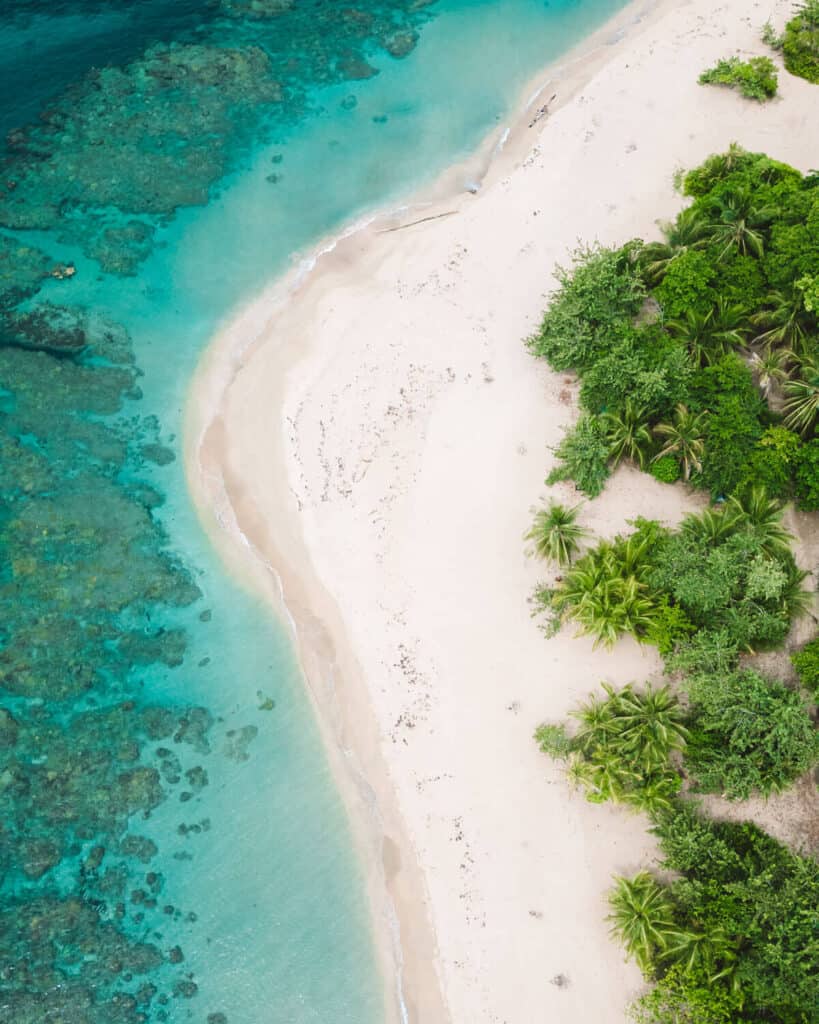


🏖️ TOP THINGS TO DO IN PUERTO VIEJO
- Hike the trail and look for wildlife at Cahuita National Park
- Visit Punta Uva Arrecife, one of the best beaches in Costa Rica
- See native wildlife at the ethical Jaguar Rescue Centre
- Get around as the locals do and ride bicycles around town
- Beach hop between Puerto Viejo's many amazing Caribbean beaches
🍛 BEST PLACES TO EAT IN PUERTO VIEJO
- Soda Cocomar
- Tamara’s
- De Gustibus Bakery
🛏️ WHERE TO STAY IN PUERTO VIEJO
- Camping: Camping Arrecife
- Budget: Playa 506 Hostel
- Mid-range: Casa BOHÖ
- Boutique: Namu Hotel
🐢 Optional stop: if you're visiting Costa Rica between July – October, you should include a stop at Tortuguero. This would be the ideal time in your itinerary to visit. Located on the northern Caribbean coast, this small town is accessible via boat only and is home to one of the largest turtle nesting areas in the country. You can take night tours to see the turtles come ashore to lay and do lots of other nature-based activities.
⏰ Driving time from Puerto Viejo to Bajos del Toro: 4.5 hours
🧭 Directions: this trip is mostly on well-made highways. Take the route that has you use Highway 4 and approach Bajos del Toro from the north.
Stop 2: Bajos del Toro
🌜 How long to spend there: 2 – 4 nights
Your next stop takes you back to the highlands of Central Costa Rica. Bajos del Toro is not on the usual Costa Rica travel route, but man, it should be! This area requires a vehicle to explore, so your great decision to take a Costa Rica road trip allows you to visit this stunning location!
This area is a waterfall wonderland, and there are dozens of cataratas to explore. And the best part? You'll most likely have them to yourself. Bajos del Toro is well known by the locals but is rarely visited by international tourists.
You could spend weeks here and still not see all the lush, breathtaking waterfalls. Bajos del Toro is everything I thought Costa Rica would be – immense nature, vivid greens and clean air.


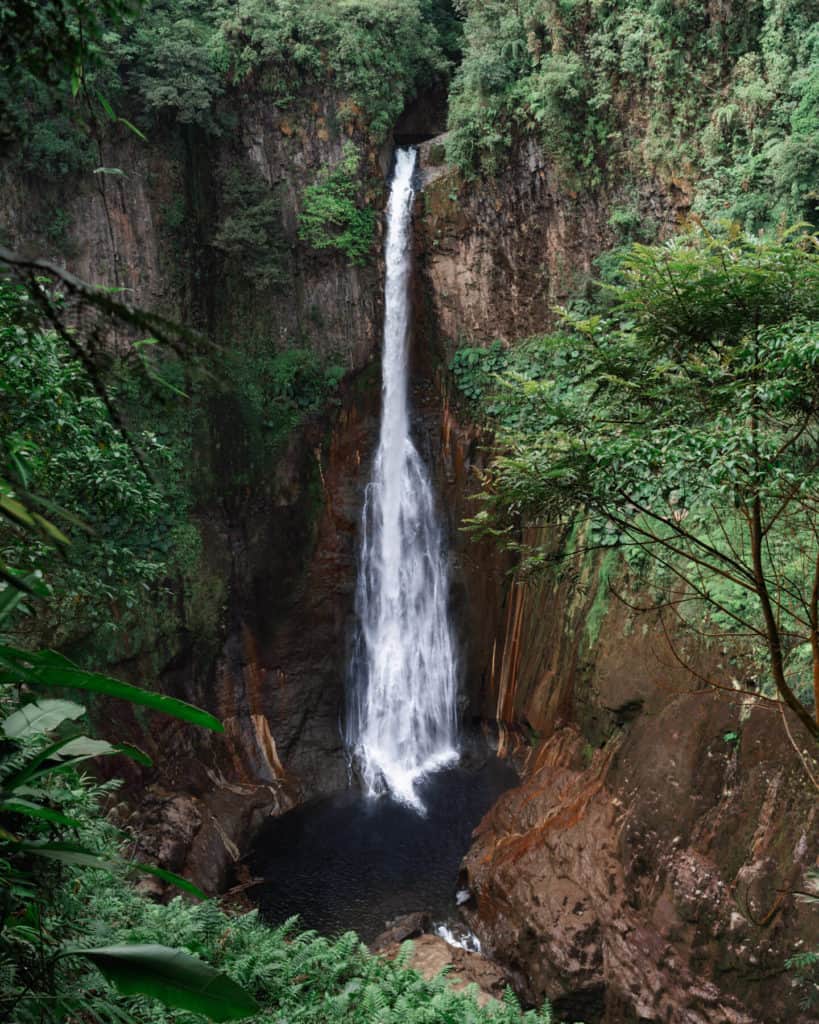
🏖️ TOP THINGS TO DO IN BAJOS DEL TORO
- Enjoy the reward of Catarata Vuelta del Cañon after a lengthy hike
- See Gatorade-coloured blue water at the Blue Falls of Costa Rica
- Admire the thundering Catarata del Toro, falling into an extinct volcano crater
- Visit the quiet and less-visited Paraiso Manantiales, with a gorgeous rainforest walk
- Tour the Jurassic Park-themed Catarata Rio Agrio
🍛 BEST PLACES TO EAT IN BAJOS DEL TORO
- Mia’s Pizza
- Restaurante Toro Amarilla
- Restaurante Alma Libre
🛏️ WHERE TO STAY IN BAJOS DEL TORO
- Camping: Vuelta del Cañon
- Budget: Selvática del Toro
- Mid-range: Blue Morpho Lodge
- Boutique: El Silencio Lodge & Spa
⏰ Driving time from Bajos del Toro to La Fortuna: 2 hours
🧭 Directions: this is a quick and easy drive once you've left Bajos del Toro and connected with Highway 4.
Stop 3: La Fortuna
🌜 How long to spend there: 3 – 5 nights
La Fortuna is easily one of the most popular tourist destinations in Costa Rica, but it totally lives up to the hype! The area is a sea of green, the towering Volcan Arenal looms over the town from wherever you look, and the wildlife spotting is excellent.
It has become a bit of a tourist town though, and you'll see offers for every kind of tour imaginable. Because you've opted to have your own vehicle, you can skip most of these, and experience the natural wonders of La Fortuna on your schedule, without the hefty price tag.
I would also recommend making the most of your freedom and staying in a more nature-centric accommodation option, outside the main town.
See old lava flows around the base of Arenal Volcano, plan an early morning visit to the magical Mistico Hanging Bridges, and soak tired muscles in the geothermal waters of El Choyin.

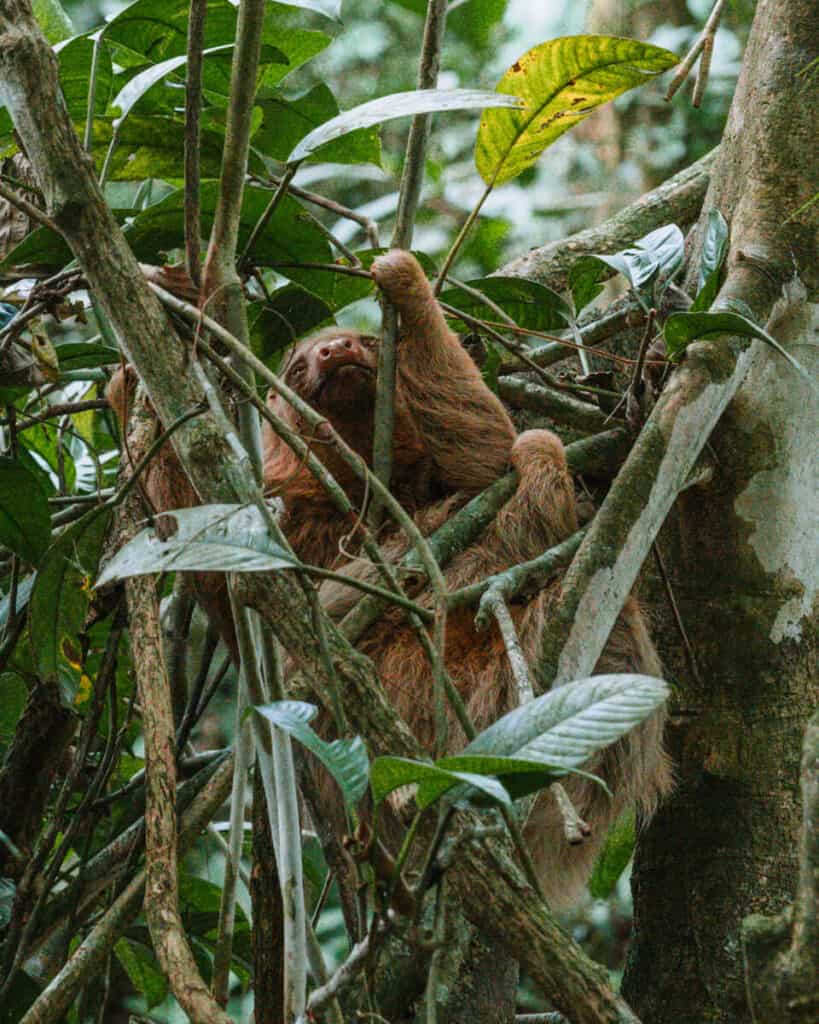

🏖️ TOP THINGS TO DO IN LA FORTUNA
- Hike around Volcan Arenal, the perfectly conical-shaped volcano that looms over town
- Experience the rainforest from above the canopy at the Mistico Hanging Bridges
- Have some fun at the free El Salto Rope Swing
- Soak in geothermal waters at the free and natural El Choyin
- Spot sloths on a guided sloth-watching tour
🍛 BEST PLACES TO EAT IN LA FORTUNA
- Soda Viquez
- Soda Hormiga
- Panadería La Principal
🛏️ WHERE TO STAY IN LA FORTUNA
- Camping: Lagos del Rio
- Budget: SantaFe Hostel
- Mid-range: Villas Las Palmas
- Boutique: Sangregado Lodge
⏰ Driving time from La Fortuna to Monteverde: 3 hours
🧭 Directions: you'll drive around the edge of Lake Arenal today. Beware of the unpaved roads and huge potholes as you approach Monteverde. If you don't have a 4×4, do some research on the best route, as Google Maps may take you a rougher way than you need to go.
Stop 4: Monteverde
🌜 How long to spend there: 2 – 4 nights
You'll ascend over 1,000 metres (3,200 ft) in elevation on the bumpy drive to Monteverde. You'll find the weather a little cooler here, creating the perfect conditions to see what we all come here for – the cloud forest.
Your car will come in handy around Monteverde, as things are quite spread out and some of the best accommodation options are on the outskirts of town in the forest.
If you're looking to cut some time somewhere in your itinerary, you can see the highlights of Monteverde in a day or a day and a half. While we did love the cloud forest, and ziplining was fun and worth it, it is somewhere you can see pretty quickly.
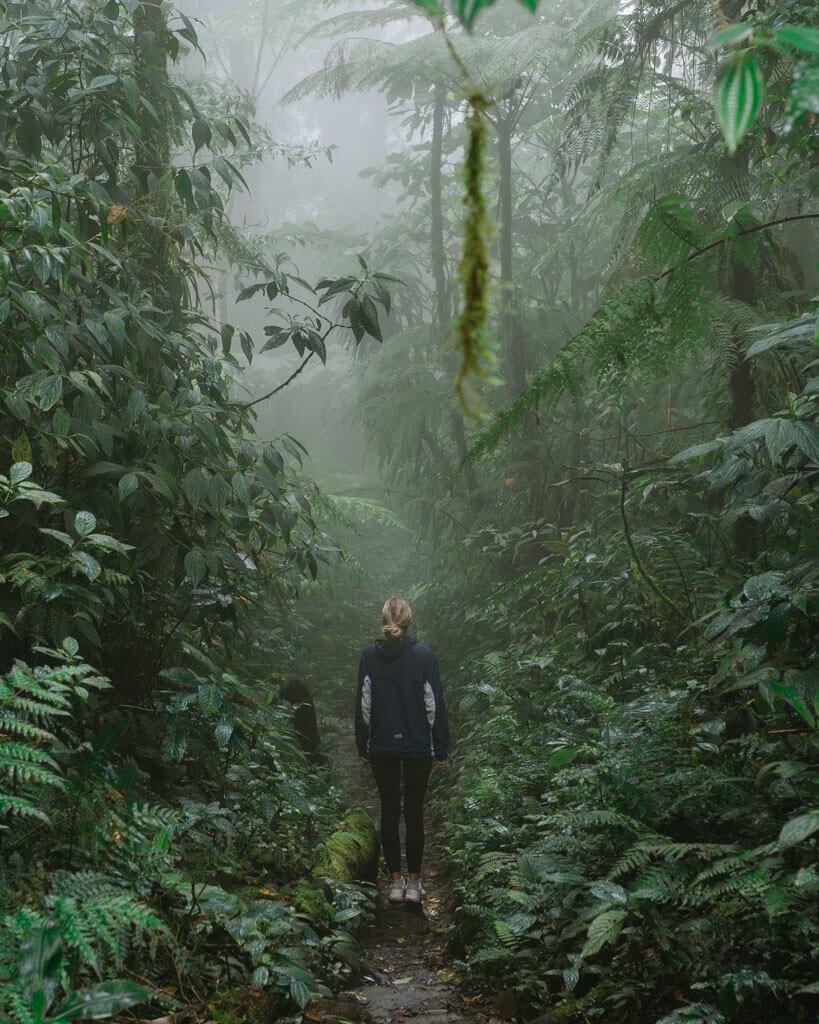
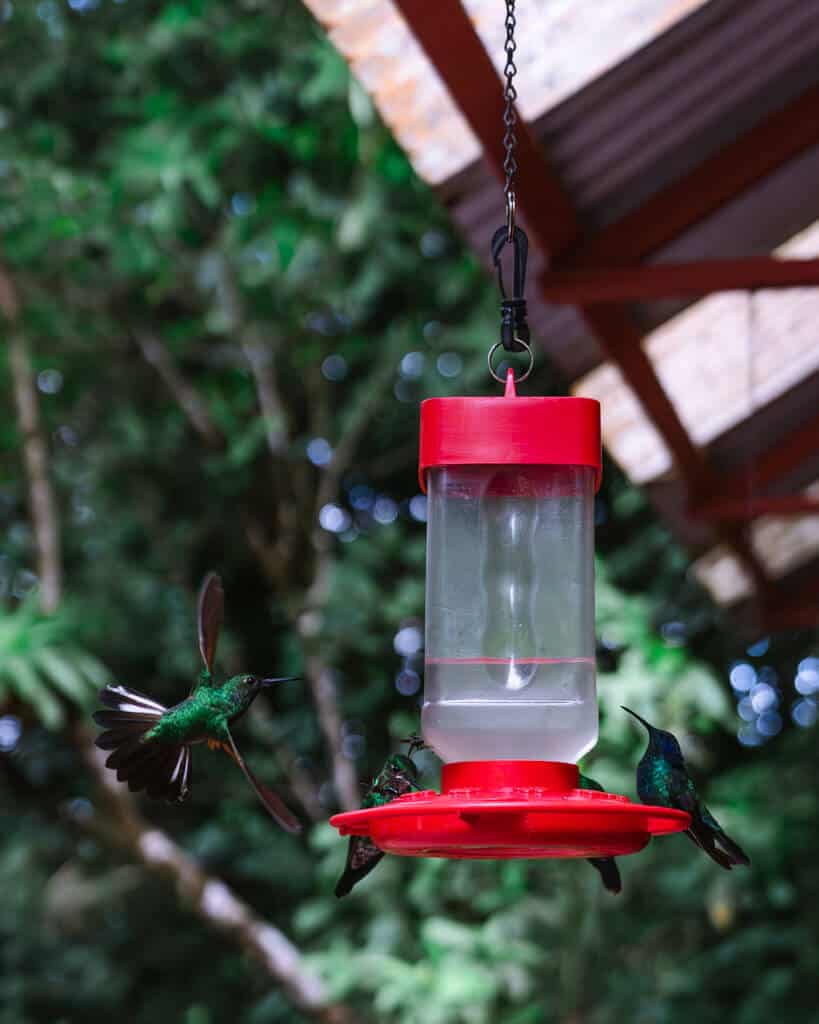
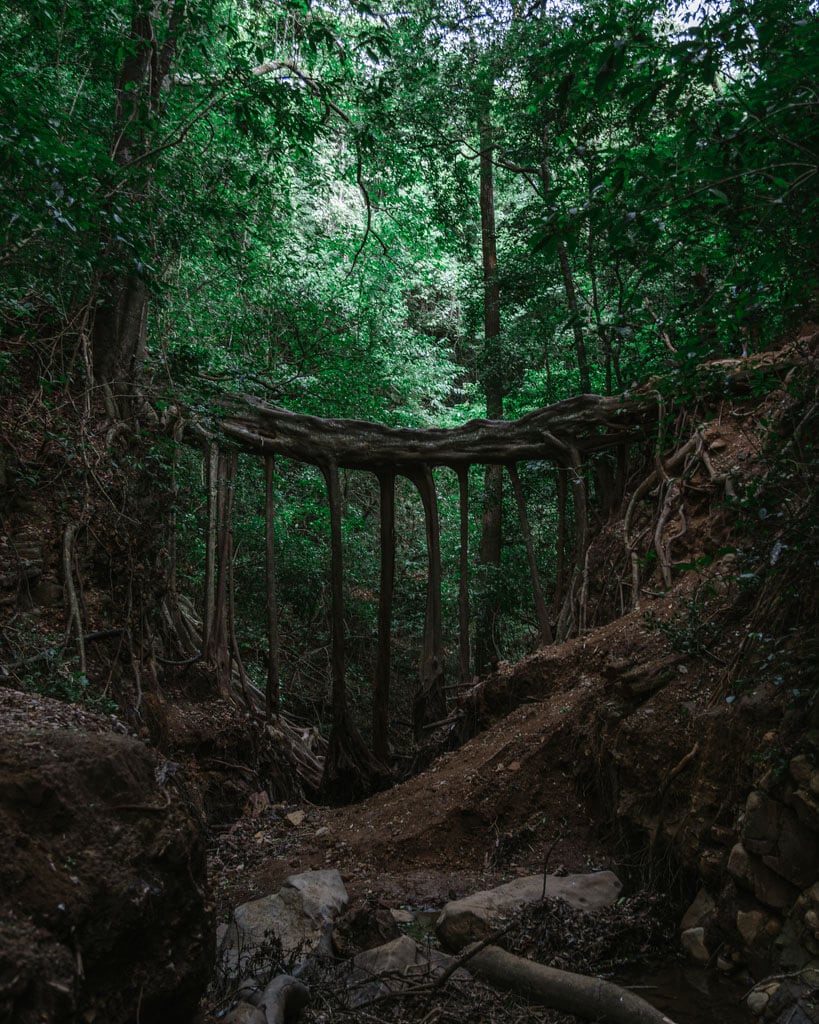
🏖️ TOP THINGS TO DO IN MONTEVERDE
- Walk through the mystical cloud forest (we recommend Santa Elena Cloud Forest)
- Go ziplining at 100% Aventura
- See dozens of colourful hummingbirds at the Hummingbird Gallery
- Marvel at the unique Ficus La Raiz, a fig tree grown into a natural bridge
- Spend the day hiking at El Tigre Waterfalls
🍛 BEST PLACES TO EAT IN MONTEVERDE
- Soda Shangri-La
- Raulito’s Pollo Asado
- Cafe Monteverde
🛏️ WHERE TO STAY IN MONTEVERDE
- Camping: Higueron Camping
- Budget: OutBox Inn
- Mid-range: Tityra Lodge
- Boutique: Chira Glamping
⏰ Driving time from Monteverde to Montezuma: 3.5 hours
🧭 Directions: the quickest way to get from Monteverde to Montezuma is to take the car ferry from Puntarenas to Paquera, on the Nicoya Peninsula. It takes 1.5 hours from Monteverde to Puntarenas, around 1 hour on the ferry, and a further 1 hour drive from Paquera to Montezuma when you land on the peninsula. You can check the ferry schedule here.
Stop 5: Montezuma
🌜 How long to spend there: 3 – 5 nights
Welcome to the Nicoya Peninsula! Although this is technically the Pacific Coast, the peninsula is a bit of a world of its own. Home to the popular tourist towns of Tamarindo and Santa Teresa, you might be wondering why we chose Montezuma.
We actually did visit Santa Teresa, and honestly? We hated it. It's expensive, crowded and completely taken over by expats and foreign ownership. Montezuma offers the same stunning Nicoya landscapes, but with a charming town that is a much more even mix of locals and expats, with a wholesome community feel.
Plus, this area has so much more to see and do! You can hike at Cabo Blanco, the first protected area in Costa Rica, swim under waterfalls, soak in rock pools and enjoy some gorgeous beaches without the high price tag.
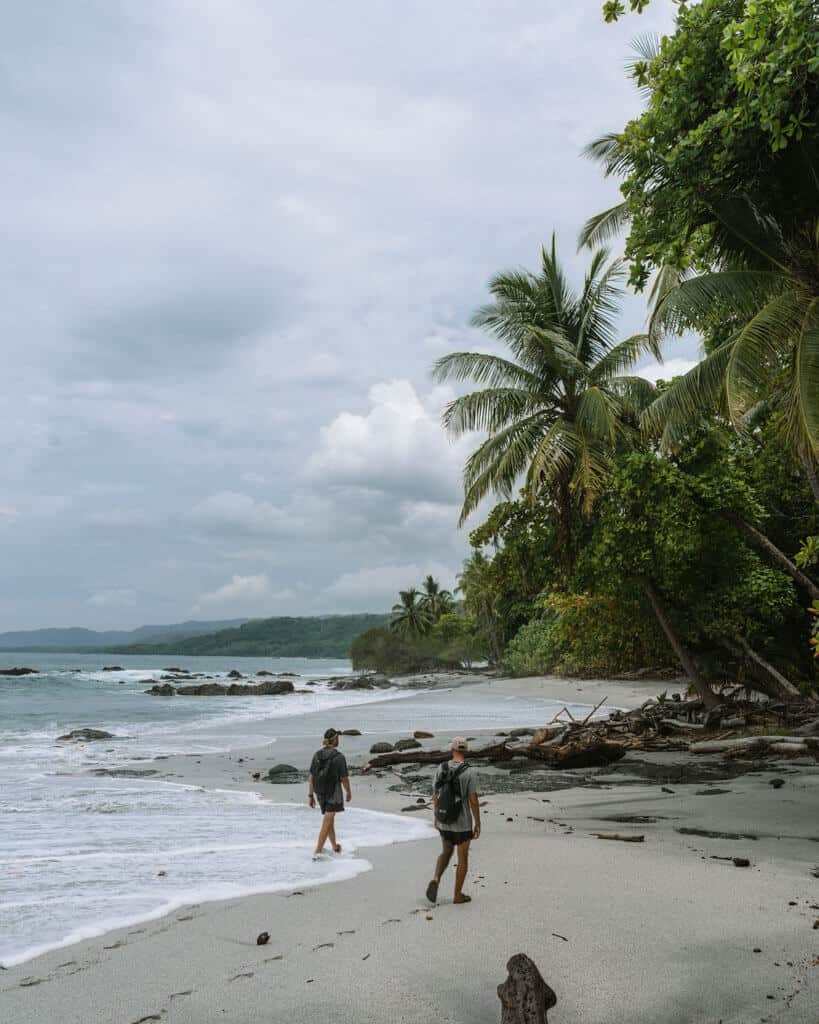
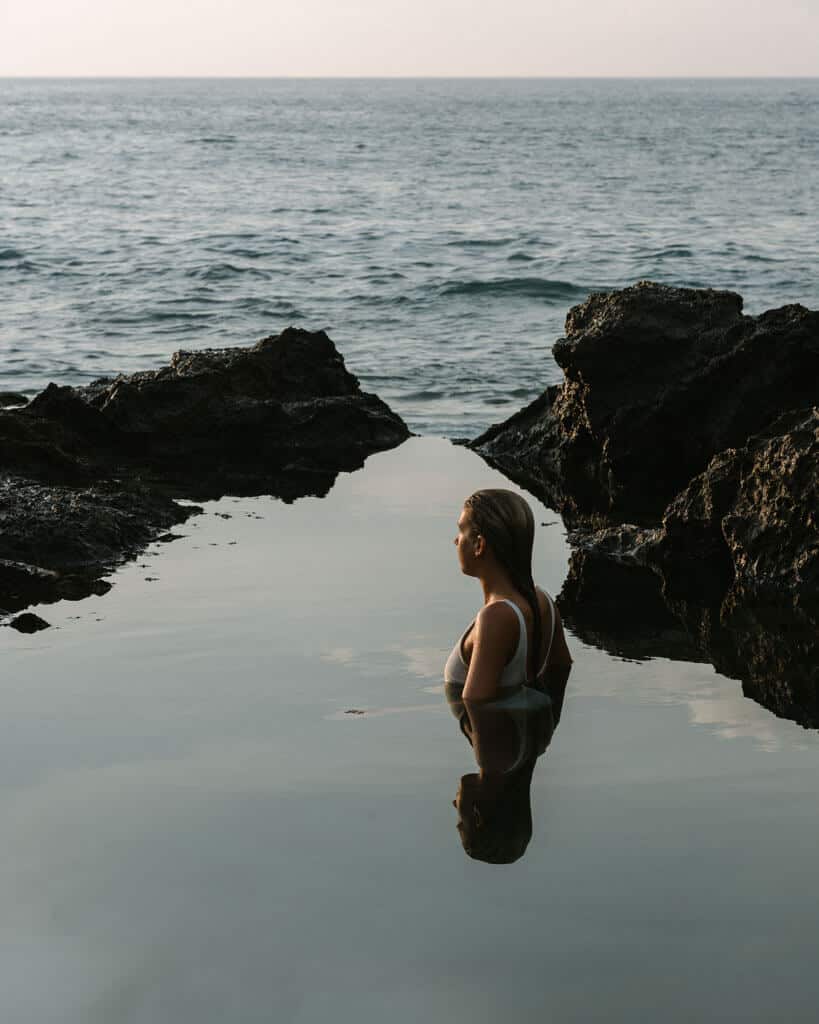
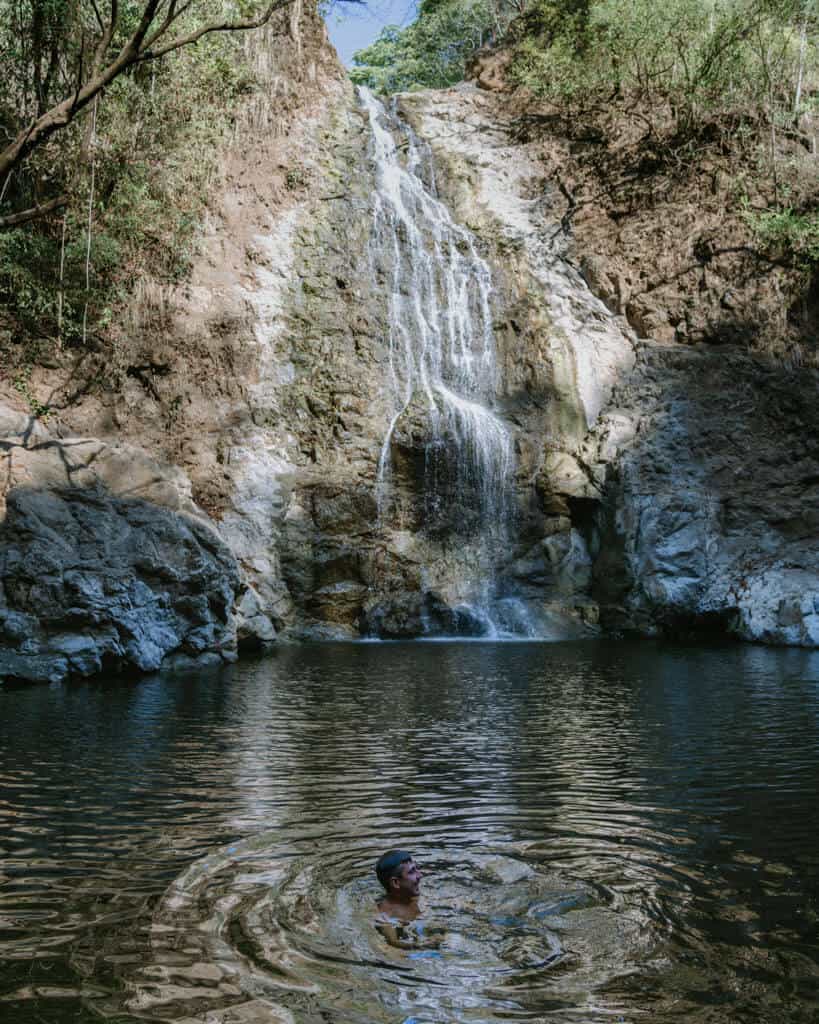
🏖️ TOP THINGS TO DO IN MONTEZUMA
- Swim in all three levels of the Montezuma Waterfalls
- Soak in the rock pools at Playa Palmeras
- Spot wildlife on the hike at Cabo Blanco Nature Reserve
- Beach hike to Playa Cocalito & El Chorro, a waterfall flowing into the sea
- Take a day trip to Isla Tortuga for snorkelling and pristine beaches
🍛 BEST PLACES TO EAT IN MONTEZUMA
- Soda Tipica Las Palmeras
- Soda La Naranja
- Butterfly Brewing Co.
🛏️ WHERE TO STAY IN MONTEZUMA
- Camping: Playa Palmeras
- Budget: Luminosa Hostel
- Mid-range: Hotel Amor de Mar
- Boutique: Hotel Nya
⏰ Driving time from Montezuma to Manuel Antonio: 4.5 hours
🧭 Directions: drive back to Paquera (1 hour) and take the car ferry from Paquera to Puntarenas (1 hour). From there, you've got a 2.5 hour drive to Manuel Antonio. Stop at the Tarcoles Crocodile Bridge on the way.
Stop 6: Manuel Antonio
🌜 How long to spend there: 2 – 4 nights
Now you're on the real Pacific Coast! Manuel Antonio is another very popular tourist destination in Costa Rica, and some people hate it. We were nearly turned off visiting altogether after all the negative reviews we read online.
But a place that has that much wildlife was worth visiting in our books, and we're so glad we did. The coastline is absolutely stunning, and the town of Manuel Antonio is stretched out along a coastal road nestled in the jungle.
It's touristy, but it's not pretending not to be (like Santa Teresa). The national park here was excellent, and we had a fantastic day exploring the trails and seeing so many animals (just be sure to go early).
This is another destination that you could see quickly if you needed to cut time. Allow at least half a day in the park, and any other time would just be spent enjoying the beaches and exploring the town. We felt 2 nights was enough.
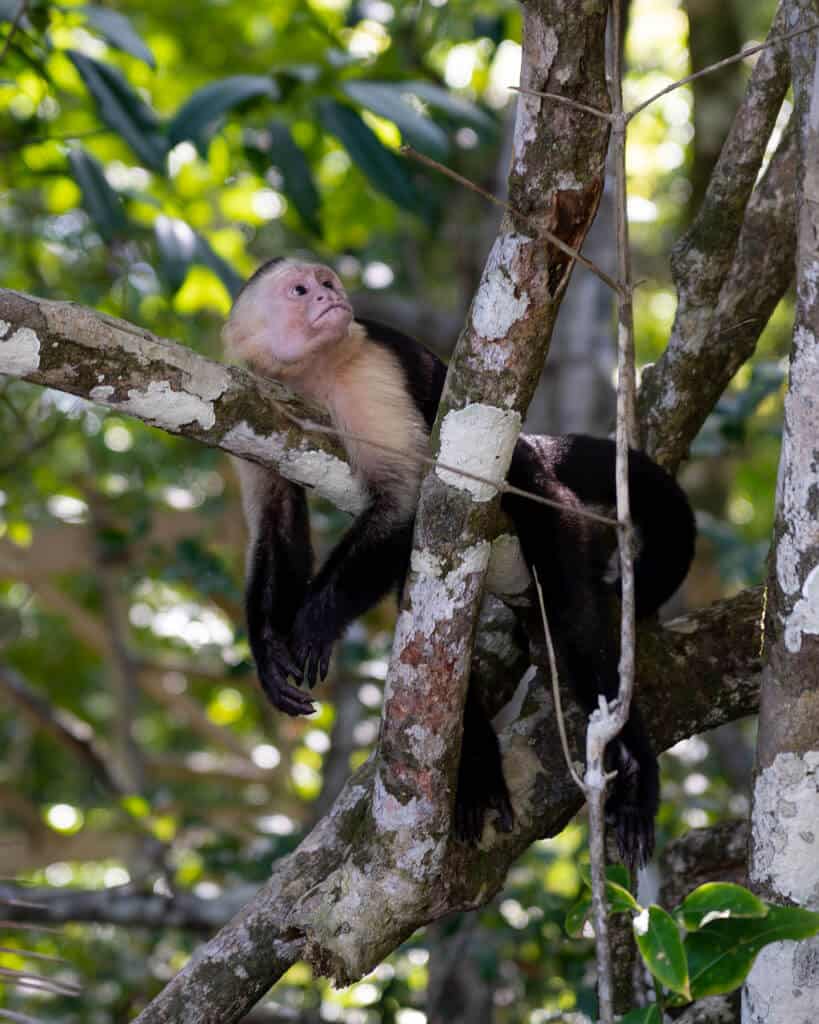
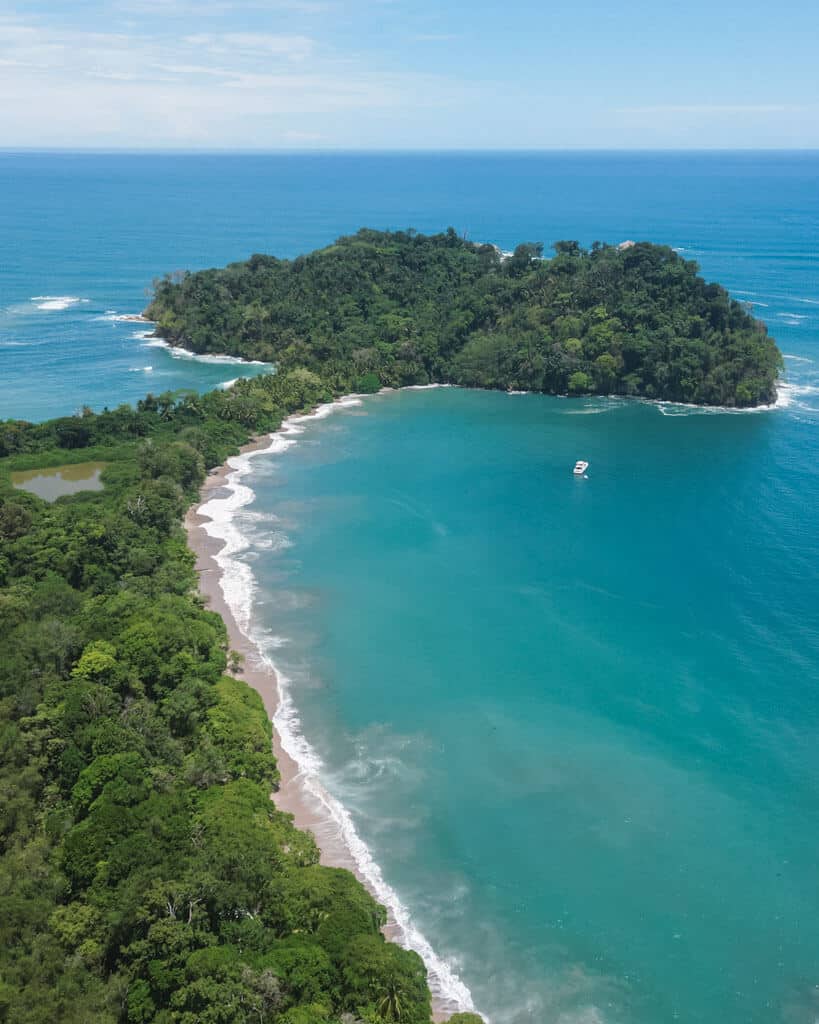
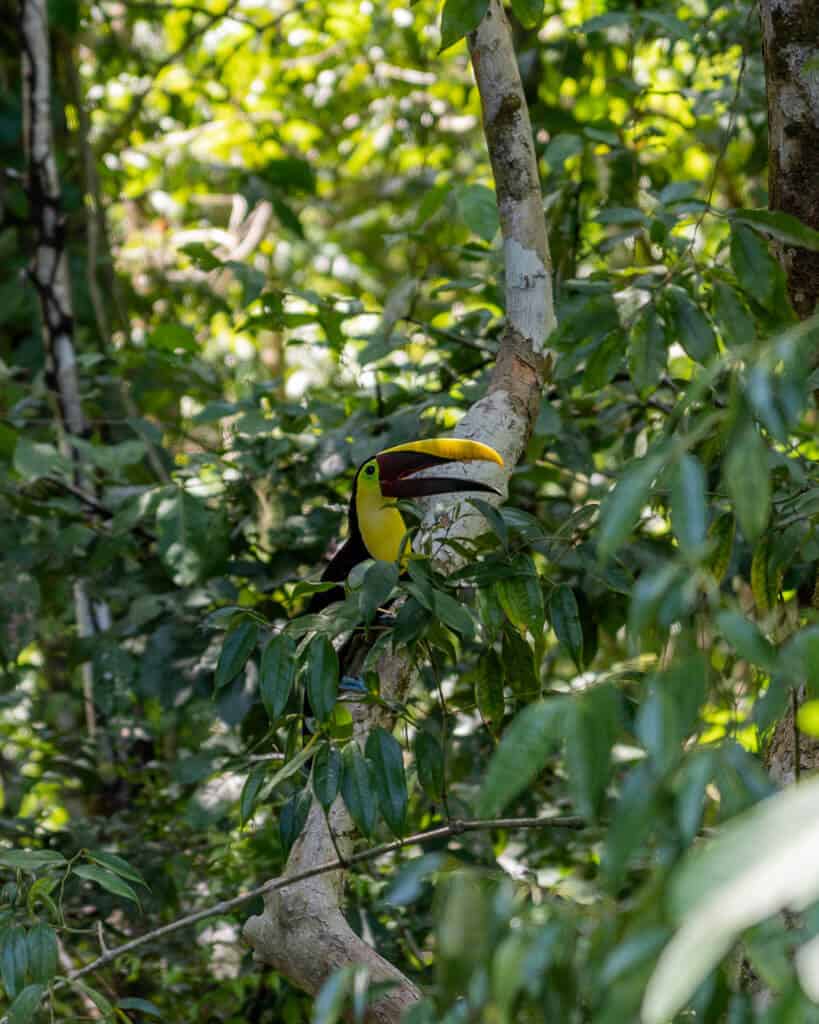
🏖️ TOP THINGS TO DO IN MANUEL ANTONIO
- Spot an abundance of animals at Manuel Antonio National Park
- Hang out on Playa Espadilla Norte, one of the best beaches
- Enjoy Biesanz Bay, a jungle-clad hidden cove
- Watch a spectacular sunset from inside an old plane at El Avion
- Visit Kids Saving The Rainforest, an ethical wildlife sanctuary
🍛 BEST PLACES TO EAT IN MANUEL ANTONIO
- Restaurante Cerdo Feliz
- Falafel Bar
- Soda El Angel
🛏️ WHERE TO STAY IN MANUEL ANTONIO
- Camping: No good options here
- Budget: Teva Jungle Hostel
- Mid-range: La Posada Jungle Hotel
- Boutique: Shana By The Beach
⏰ Driving time from Manuel Antonio to Uvita: 1 hour
🧭 Directions: this is a quick and easy drive straight down the Costanera Sur Highway. You'll pass by Dominical, but resist the temptation to stop – you'll be back there in a few days.
Stop 7: Uvita
🌜 How long to spend there: 2 – 4 nights
Your next stop is deeper along the Pacific Coast and one where you will be very thankful to have a car as Uvita is very spread out.
We actually hated the ‘town'. The highway runs right through, it's commercial, noisy and not particularly scenic. But head south towards the coast, or north towards the jungle, and you'll find the appeal of Uvita.
The beach is what everyone dreams a Costa Rican beach to look like – lined with palm trees, stretching on for miles, with gorgeous sunsets. It couldn't be more perfect.
Throw in the unique whale tail, actual whales to see offshore for 10 months of the year and some lush waterfalls in the jungle, Uvita captivated us in the end.

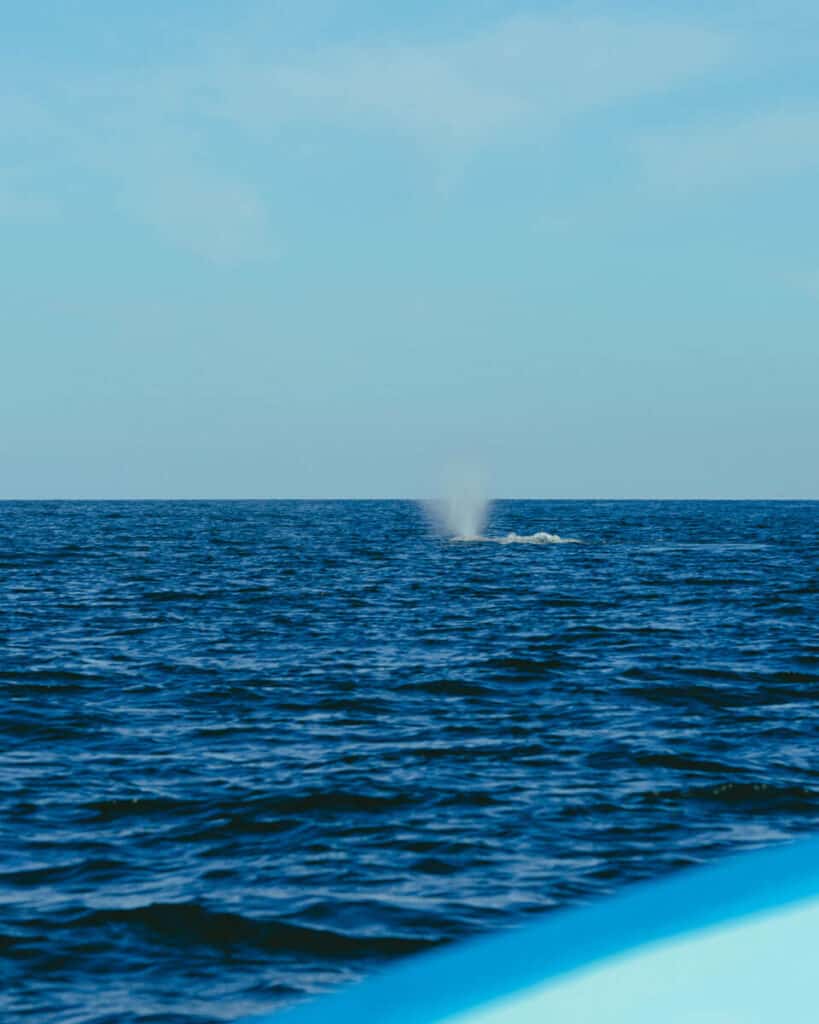

🏖️ TOP THINGS TO DO IN UVITA
- See the famous whale tail at the Marino Ballena National Park
- Swim in the lush Uvita Waterfall
- Go humpback whale watching between December – April & July – November
- See rescued wildlife at the ethical Alturas Wildlife Sanctuary
- Visit the secluded Cascada El Pavon
🍛 BEST PLACES TO EAT IN UVITA
- Soda Ranchita Doña Maria
- Uvita Gastro Park
- Le French Cafe
🛏️ WHERE TO STAY IN UVITA
- Camping: Camping Casa Viva
- Budget: Hostel Cascada Verde
- Mid-range: Ballena Rey Hotel
- Boutique: Vista Celestial
⏰ Driving time from Uvita to Drake Bay: 3 hours
🧭 Directions: you should only drive to Drake Bay if you have a 4×4 (3 hours). If you don't drive to Sierpe (1 hour), pay to park your vehicle and take the boat to Drake Bay (1 hour). Read more about getting to Drake Bay here.
Stop 8: Drake Bay
🌜 How long to spend there: 3 – 5 nights (including an overnight in Corcovado National Park)
Deep in the southwest corner of Costa Rica on the Osa Peninsula, Drake Bay is raw and wild. The first thing we saw when we arrived in town was a crocodile chilling on the banks out the front of a restaurant. That's what Drake is like!
Your Costa Rica road trip might temporarily end here if you don't have a 4×4 and can't drive into town. But don't worry, you don't really need your car.
The highlight and number one priority of your time here is Corcovado National Park. Drake Bay is one of two gateways to the park, and you have to do an overnight tour of the Sirena Ranger Station. It costs a pretty penny, but trust me, every other experience you've had in Costa Rica has led you to this moment.
Luckily you can make up the funds by doing the free Drake Bay trail, which leads you past stunning empty beaches with lots of wildlife to see.



🏖️ TOP THINGS TO DO IN DRAKE BAY
- Experience the biodiversity of Corcovado National Park (stay overnight if you can)
- Hike the Drake Bay Trail past dozens of beaches
- Go snorkelling or scuba diving at Caño Island
- Spot nocturnal critters on the Bug Lady Night Tour
- Float down the Rio Claro on a unique tour
🍛 BEST PLACES TO EAT IN DRAKE BAY
- Las Delicias
- Fast Food Truck Gaby’s
- Marea Alta
🛏️ WHERE TO STAY IN DRAKE BAY
- Camping: Ganadito Camping
- Budget: Life for Life Hostel
- Mid-range: Pacheco Beach Cabins
- Boutique: Copa De Arbol Resort
⏰ Driving time from Drake Bay to Dominical: 3.5 hours
🧭 Directions: if you drove to Drake Bay, you've got a 3.5 hour drive to Dominical. If you parked at Sierpe, take the boat back (1 hour) and drive on to Dominical (1.5 hours).
Stop 9: Dominical
🌜 How long to spend there: 2 – 4 nights
Dominical is only half an hour away from Uvita, and it's possible to do the same activities from either location, so you might be wondering why we've recommended this as a separate stop on your Costa Rica road trip.
Firstly, it really helps to break the drive back from Drake Bay. You would be driving for 7+ hours trying to get all the way back to San Jose in a day. Secondly, Dominical feels totally different from Uvita, and we much preferred it as a beach town.
The rightfully famous Nauyaca Waterfalls are closer to Dominical than Uvita, so you can get there first thing to beat the crowds. Playa Dominicalito is a tropical paradise and the perfect place to spend some of your final day relaxing in Costa Rica.



🏖️ TOP THINGS TO DO IN DOMINICAL
- Swim under the spectacular Nauyaca Waterfalls
- Hang out on Playa Dominicalito, a stunning palm-lined beach
- Go surfing in Dominical if you're a pro, or at Dominicalito if you're learning
- Enjoy the free and quiet Cascada Poza Azul
- Watch the sunset from Rocas de Amancio, a unique rocky island accessible at low tide
🍛 BEST PLACES TO EAT IN DOMINICAL
- Phat Noodle
- Cafe Mono Congo
- Fuego Brewing Co.
🛏️ WHERE TO STAY IN DOMINICAL
- Camping: Playa Dominicalito
- Budget: Cool Vibes Beach Hostel
- Mid-range: Bamboo River House
- Boutique: Tribe Boutique Hotel
⏰ Driving time from Dominical to San Jose: 3.5 hours
🧭 Directions: for the quickest and easiest journey back to San Jose, take the toll roads. If you are heading straight to the airport give yourself plenty of time. Traffic can be terrible coming into the city.
Finishing your Costa Rica road trip in San Jose
Your time in Costa Rica has sadly come to an end!
If you’re flying straight out of San Jose, try and book a flight for the late afternoon or evening, so you can avoid spending the night in the city.
Remember to factor in plenty of time for the drive from Dominical to San Jose, as the traffic can be slow coming into the city. You’ll also need to allow a bit of time to return your car. They’ll need to inspect it for damage, refund any security deposits etc.
Your rental car company will drop you back at the airport.
GET OUR COSTA RICA ROAD TRIP GUIDE
A 23-page mini road trip guide for Costa Rica, including our route and itinerary plus where to eat, stay and play in 9 destinations.

Alternate route for Central American travellers
If Costa Rica is part of a broader trip through Central America, you won’t necessarily be arriving or departing via San Jose.
To cater for this, I would suggest changing the route a little bit to avoid backtracking. This is similar to what we ended up doing ourselves as we came in from Nicaragua and left for Panama.
👉🏼 Nicaragua – COSTA RICA – Panama
If you’re entering from Nicaragua, I would suggest taking the Nica or Tica bus straight to San Jose. You can pick up your car from here as normal. The only change I would make to this route is to NOT go to Puerto Viejo with a car. Skip stop 1, follow the rest of my itinerary as recommended, drop the car off in San Jose and take the bus to Puerto Viejo. A car is not absolutely essential here, and it means you can cross the border to Panama (Bocas del Toro) very easily from this area, without needing to backtrack and return the car to San Jose.
👉🏼 Panama – COSTA RICA – Nicaragua
If you’re coming from Bocas del Toro, I would suggest you cross the border to Puerto Viejo and enjoy the South Caribbean without a car. As mentioned, it’s not essential in this area, and the combination of bicycles and local buses makes it easy to get around. From here, take the bus to San Jose, collect your rental car and complete the route as planned. Drop the car back in San Jose, and get the Nica or Tica bus across the border to Nicaragua.

There is no doubt you would have seen and done incredible things during your Costa Rica road trip. You’ll be daydreaming about the palm tree-fringed coastline, reminiscing on all the wildlife you spotted and imagining yourself back under a thundering waterfall in the jungle for months to come. Please get in touch and let me know how your trip went!
MORE COSTA RICA POSTS


The Comments
Jennifer
Hi Sally,
Your site and information are amazing. When I found it, I thought that it had all the sites I would like to see….then I counted the days. 🙂 By any chance, could you tell me what you would do to shorten it down to about 14-15 days? Would it help to fly in and out of the two different airports? Any advice you can offer would be greatly appreciated.
Thank you!
Jennifer
Sally Rodrick
JenniferHey Jennifer, yes it is a huge country with SO much to do. As tempting as it can be to cram in more places, I promise you will enjoy yourself more if you slow it down and allow enough time to properly experience each destination. Rushing and spending the entire time driving is not fun.
It’s so tough to narrow it down and it totally depends what you’re interested in. My two favourite places (Corcovado National Park/Drake Bay and Puerto Viejo) are on opposite sides of the country, so that makes it hard.
I think if wildlife is your priority, Corcovado is unmissable and I’d plan backwards from there. Manuel Antonio and the Caribbean Coast are also great for wildlife, but nothing compares to Corcovado.
You can also cut from the beach destinations and choose one or two. As I said, PV and the Caribbean was by far my favourite beach destination, but sadly it is out of the way if you also want to visit Corcovado. You could visit both places, but you wouldn’t be left with a lot of other time in between and I don’t see a way to avoid at least 2 huge driving days.
I’d suggest dropping the Nicoya Peninsula and skipping Montezuma/Santa Teresa (although it is lovely, it’s out of the way), and choosing one or two places, out of Manuel Antonio (great for wildlife), Uvita (great for whales and gorgeous beach but not so nice town) and Dominical (more beach town vibes and close enough to Uvita to do both, also some great waterfalls). This keeps you aligned to the Pacific Coast as all these places are on the way to Drake Bay.
Then you can do Bajos del Toro, La Fortuna and possibly Monteverde too. I’d start there, then go to say Uvita or Dominical, down to Drake Bay, back to Manuel Antonio and then back to San Jose from there to break up a long drive. I don’t think it’s worth flying out of different airports. Unless you could fly from Drake Bay back to San Jose and then connect to your flight from there. But you’d be left with a car that you couldn’t drop off in that area I don’t think.
Hope that helps a bit and gives you some ideas! Sadly you need to be brutal and drop a few destinations, although they are all amazing!
Enjoy, Sally x
Jennifer
Thank you for the help, Sally! 🙂
Susanne
Hello: Thank you so much for such fabulous information! I guess my question is a bit like Jennifer. We may not need as much time either because we are older (67 and 69) and I do not see ziplining in our futures! Any suggestions for the “older” folks? Thank you so much! Sus
Sally Rodrick
SusanneHi Susanne, it totally depends what your priorities are. Beach? Nature/hiking? Wildlife? I think the same suggestions apply as what I mentioned for Jennifer. First choose your priorities and decide which destinations are best for that. For wildlife, Corcovado, Manuel Antonio, Puerto Viejo and La Fortuna, beaches you can easily cut down on as you don’t need to visit all of them. I’d opt for one beach area. The Caribbean coast was my favourite, but it might depend on where else you are visiting (e.g. if you go to Corcovado and Drake Bay, you probably need to choose a Pacific beach destination if you’re short on time). A lot of places do have some extreme/more physically demanding activities, like ziplining, but they also have so many softer and lighter activities that it’s not worth striking them out completely, like Monteverde 🙂 I think you need to work out what is a top priority for you and how much time you’ll need for those places, and fill the gaps with the time that you have left. Working out if you want to visit both or just one coast is also a good first step. I hope that helps! Sally
Abbie
We only have about 4 nights in Costa Rica. What top places would you recommend?
Sally Rodrick
AbbieHi Abbie, with just 4 nights I’d probably suggest just one destination to avoid time travelling. I’d probably say Puerto Viejo, for a good mix of beach, jungle and wildlife. Otherwise Manuel Antonio offers something similar on the Pacific Coast. Hope that helps! 🙂
Alice
Hi Sally, I’m currently planning a roughly 3 month trip around central America for the beginning of next year and I’m finding your blog an incredible resource! I think we prioritise similar things when traveling, quiet spots and plenty of wildlife/natural beauty. I’m currently planning out about 16 days in Costa Rica using this guide and your comment to Jennifer below to make sure we see everything that’s most important to us 🙂
I wanted to ask, is there a reason that you haven’t got any specific posts on your website about Nicaragua? Have you not spent as much time there as in the rest of the region, or would you not recommend traveling there? I’m just curious!
Thank you for creating such an incredible resource <3
Sally Rodrick
AliceHi Alice, how exciting! You’ve got an incredible trip ahead of you. It’s an amazing, intense and at times challenging part of the world to explore, but so rewarding. The tough part as you know is choosing where to go! Especially in Costa Rica as everywhere is so beautiful and pristine.
Yes we definitely went to Nicaragua, I just haven’t gotten around to writing about it yet! I’m working on the Panama posts right now, and I’m hoping to start publishing Nicaragua guides next month. It should all be done before you leave, but maybe not before you lock in some plans, apologies!
Nica was a country of ups and downs for us. It had some of our top places in all of Central America (Corn Islands, Ometepe, Leon) but also some really challenging parts. We found travelling there incredibly hard, as the poverty, political situation and lack of care for the environment really wore us down and we were often frustrated. Some people love Nica more than anywhere, but I often find that those people are backpackers who lock into the hostel and party trail and enjoy the cheap prices, maybe without understanding or seeing the ‘real’ Nica. Cheap is good, but by the time we got to Costa Rica it felt like a breath of fresh air to see protected, clean and green nature, and to see people living generally happy lives. We were happy to pay that, but we also find the whole ‘Nica is so cheap and Costa Rica is so expensive’ argument to be untrue, many things in Nicaragua were just as expensive if not more than CR.
There are some horrible things happening in Nicaragua and I think it is great to travel there, pump some money into the economy and try and make yourself aware, but for us, it was intense and challenging. We were safe, and you definitely should visit, but I had such high expectations based on whatever everyone else says about the country, but it wasn’t our favourite.
My top tip is that the Pacific Coast, for us at least, was a massive let down and not worth that much time. San Juan del Sur was probably the worst beach/surf town we visited in 6 months, it was so seedy, full of drunk/drugged backpackers and was dirty, overdeveloped and busy. We visited Playa Maderas which was better, and Popoyo further north was OKAY, but we much preferred the Pacific Coast of El Salvador if you’re trying to decide which surfy towns to spend the most time in. Costa Rica’s Pacific towns were much better too, although we found their Caribbean coast much better, so much more chilled and less developed.
Sorry there’s a lot to unpack in that!! I hope it helps, and please keep checking back for the Nicaragua content, I’m typing as fast as I can and so excited to finally complete the final pieces!
Sally xx
Sonia santos
Hi Sally!! I’m so happy I found you! Unfortunately, we would only have about 10 days to spend and beautiful Costa Rica because of our schedules. Our priorities are beautiful beaches and seeing wildlife my husband has never been to Costa Rica, but I have been a few times. If you could give her a recommendations for possibly three locations that would be great. You are the experts so I am open to any suggestions!
Sally Rodrick
Sonia santosHi Sonia, sounds like you’ve got an exciting trip planned! For beautiful beaches and wildlife I’d say Puerto Viejo and the Caribbean Coast, Drake Bay and Corcovado National Park or Manuel Antonio. You couldn’t do all three of those in 10 days as they’re opposite sides of the country! But they’d be my top choices for what you’re looking for, choose which one appeals to you most and plan the rest of your itinerary around that 🙂 Hope that helps! Sally
Kim
This was awesome. Thank you!
Sally Rodrick
KimSo glad it was helpful Kim! Enjoy Costa Rica.
Brenda
Hi Sally!
Thank you for this amazing info! I’m planning a trip to Peru & CR with my husband and two daughters (11 & 13) in June. Our priority is seeing wildlife, especially jaguars & other cats. My older daughter went to CR on a school trip last year (she wants to work in wildlife conservation) and they visited Manuel Antonio & La Fortuna, so the #1 priority is Corcovado. But I’d also love a great beach… I’d been thinking Quepos but am now leaning toward Puerto Viejo, based on your enthusiastic recommendation. I’m mapping out our trip and am confused because there are three Puerto Viejos! One is in Guanacaste Province, one in Heredia & one in Limon. I’m assuming the one I want is Puerto Viejo de Talamanca in Limon since it’s on the Caribbean coast, but would you mind confirming that for me? Thank you!!
Sally Rodrick
BrendaHi Brenda, I’m so sorry I should have clarified, yes I meant Puerto Viejo de Talamanca in Limon on the Caribbean Coast! If your daughter has already been to Manuel Antonio you could skip Quepos. I think PV is the best beach town, but if you want to stick with the Pacific Coast after Corcovado, you could also consider Uvita or Dominical. There are some sights and wildlife around there, but my vote is always for PV if you’ve got the time and are happy to travel to the other side of the country. I hope you have the best trip! What a wonderful experience to do with your daughters, Corcovado is so special. Sally